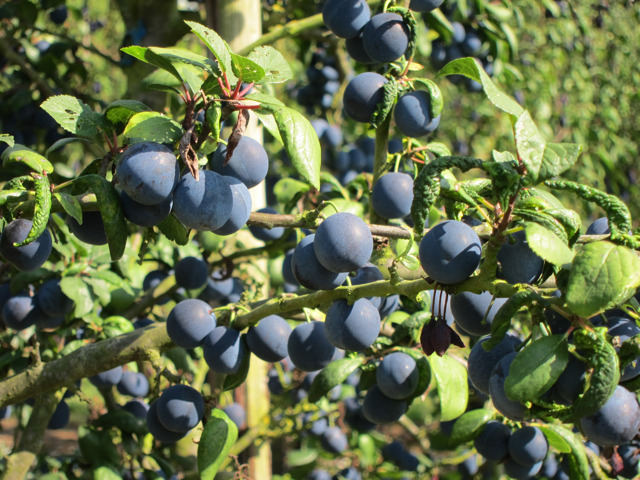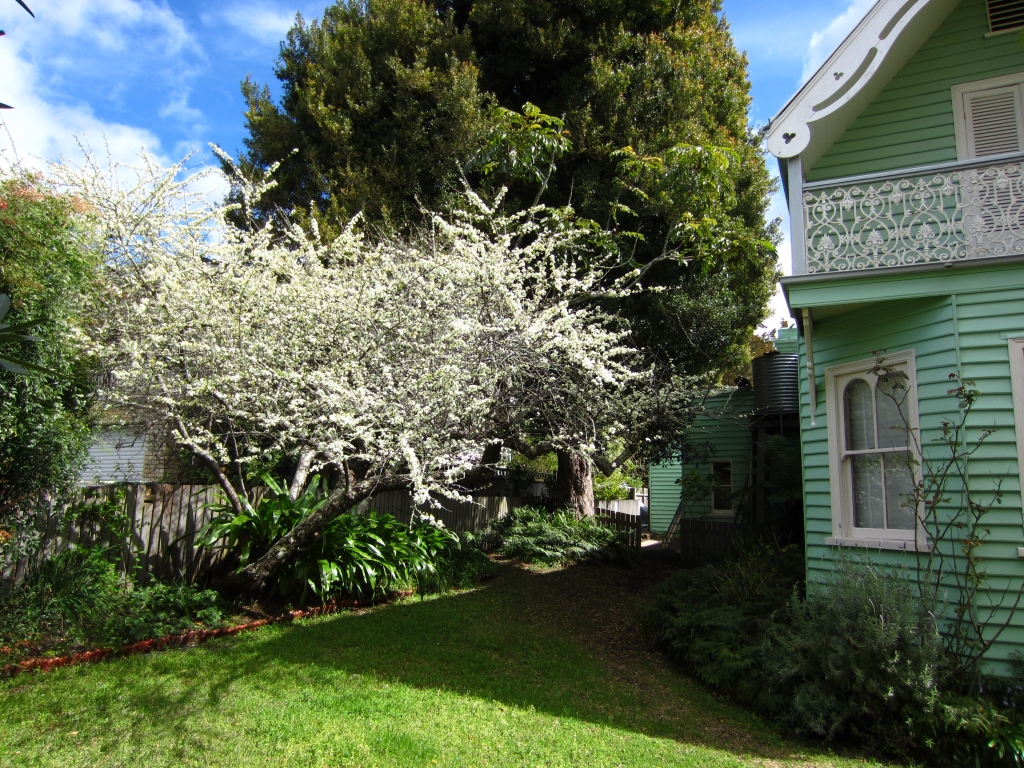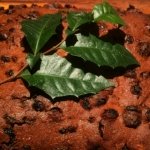It looks like Spring has well and truly arrived at Meroogal, with the damson plum bursting into bloom by the side of the house!
Fortunately the plum has flowered now and not a week or two earlier or the buds of its beautiful white blossom would have been swept away by the fierce storms that hit the New South Wales South Coast in late August. It’s far from the first time the first time that the region has been battered, with flooding a fact of life along the Shoalhaven river. In the hall at Meroogal is a clock, thought to have been brought from Scotland by the house’s designer Kenneth McKenzie in 1839, that was thought lost when the great flood of 1860 (the water rose up to 120 feet at one point!) inundated the family house at nearby Terara. Pieces were later found washed ashore in a tangle of debris and, with a new case made, it was amazingly put back into working order. When Nowra, including the plots that became Meroogal, was first surveyed it was laid out high above the river, safe from inundation.

5-petaled damson blossom at Meroogal in 2015. Photo (c) Scott Hill for Sydney Living Museums
The damson plum
Damsons (Prunus domestica subsp. insititia) are not a common fruit these days. In 19th century British guides you read of a range of cultivars: Loudon thought the ‘Shropshire Damson’ the “best of the Damsons for preserving” [1]. Damsons are an attractive fruit, like a small, ovoid ‘egg’, and usually a rich dark blue-purple in colour, while their flesh can be white through to yellow.

‘Damsons at Brogdale Farm’. Photo (c) Oast House Archive used under Creative Commons License.

‘Damson, Prunus insititia’. Photo (c) Jonathan Billinger, used under Creative Commons License.
The diaries of Kenneth McKenzie’s niece Tottie Thorburn (written between 1888 and 1896) only mention Damson plums once, in 1890 when she was at Meroogal:
Wednesday 26th February, 1890: Up very early & made scones etc. went to Nowra by coach Preserved damsons & made scones for the [Nowra Agricultural] show everyone in the house was very busy. [2]
…however two years later, on February 10th, 1882, she also records “preserved plums” at Nowra, and it is most likely these were also Damsons, and also intended for the Nowra show which opened 19th February that year.
Kennina (Tottie) Fanny McKenzie Thorburn, 1886. Grouzelle & Cie. Sydney Living Museums, June Wallace papers, Rec no 43029
Damson plums were described by Loudon as ‘kitchen’ plums, as opposed to ‘dessert’ plums which can be eaten ‘as is’. Though high in sugar they are quite face-puckeringly tart, and are far better when used in cooking. The damsons and other fruit that Tottie and her sisters used to make preserves, jams, cakes and puddings came from the fruit trees in the large orchard behind their house (long lost to subdivision). In this view you can see Tottie’s niece Helen Macgregor standing in front of a huge Damson in bloom. The photograph was taken around September, 1930, some 38 years after Tottie was preserving damsons for the Nowra show, and it’s possibly the same tree whose fruit she had picked:
Helen Macgregor in the front of the orchard fence at Meroogal Nowra around 1930. Photographer unknown. Caroline Simpson Library & Research Collection, June Wallace papers
Helen Macgregor in the front of the orchard fence at Meroogal (detail). Photographer unknown, Caroline Simpson Library & Research Collection, June Wallace papers
The old tree we see flowering today is a few feet north of that original (today’s recreated paling fence is in approximately the same location as that seen in this view), and quite likely grew from a sucker of the original [3]:

The Damson plum flowering in the front garden at Meroogal in 2015. Photo (c) Scott Hill for Sydney Living Museums
To preserve damsons
This recipe for preserved damsons is from Mrs Beeton’s Dictionary of Every-day Cookery (London, S.O. Beeton, 1865):
DAMSONS, Preserved.
Ingredients.—To every quart of damsons allow 1/2 lb. of loaf sugar. Mode.— Put the damsons (which should be picked from the stalks and quite free from blemishes) into a jar, with pounded sugar sprinkled amongst them in the above proportion; tie the jar closely down, set it in a saucepan of cold water; bring it gradually to boil, and simmer gently until the damsons are soft, without being broken. Let them stand till cold; then strain the juice from them, boil it up well, strain it through a jelly-bag, and pour it over the fruit. Let it cool, cover with oiled papers, and the jars with tissuepaper brushed over on both sides with the white of an egg, and store away in a dry place. Time. — About 3/4 hour to simmer the fruit after the water boils; 1/4 hour to boil the juice.
Basically, the cleaned damsons are cooked in a simple sugar syrup – carefully, so they don’t break their skins and definitely not stirred – then allowed to cool and the liquid carefully removed. The syrup is then reduced, strained through a cloth (jelly bags were made of a fine flannel), and poured back over the damsons. Nowadays a good preserving jar with lid does away with the need for the oiled papers. This variant recipe published in 1897 uses suet to create a seal, essentially ‘larding’:
Ingredients : Damsons or plums ; boiling water. Mode : Pick the fruit into clean dry store jars, taking care to leave out all that are broken or blemished. When full, pour boiling water on the plums, until it stands 1 in[ch]. above the fruit ; cut a piece of paper to fit the inside of the jar. over which pour melted mutton-suet ; cover down with brown paper, and keep the jars in a dry, cool place. When used, the suet should be removed, the water poured off, and the jelly at the bottom of the jar used and mixed with the fruit. [4]
“But what about Tottie’s entry in the show?” I hear you cry. Well despite her efforts she didn’t win for her preserved damsons, however on the 27th she did write:
“Show day, lovely morning, everybody seemed to be astir early. George got first prize for point lace & I got first for scones. Saw a good many old friends. Kate Mr Blackmore & I went to an entertainment at night & enjoyed it very well”
Second helpings
[1] J C Loudon The Suburban Horticulturist; or, an attempt to teach the science and practice of the culture and management of the kitchen, fruit, & forcing garden to those who have had no previous knowledge or practice in these departments of gardening. (London Wm. Smith 1842, p559)
[2] You can read more from Tottie’s diaries here.
[3] Damsons grow freely from suckers, which is their usual method of propagation.
[4] ‘The Ladies’ page: Answers to Correspondents By Thalia’. The Sydney Mail and New South Wales Advertiser, 10th July 1897.
Images notes
‘Damsons at Brogdale farm’, © Oast House Archive. Image source: Geograph, retrieved 5 9 2015 and licensed for reuse under creative commons licence.
‘Damson, Prunus insititia’ © Jonathan Billinger. Image source: Geograph, retrieved 5 9 2015, and licensed for reuse under creative commons licence.


